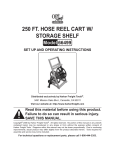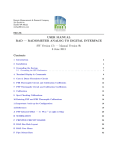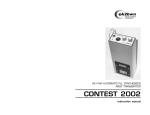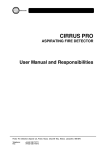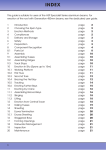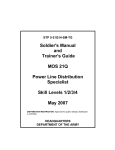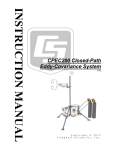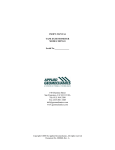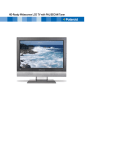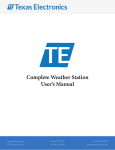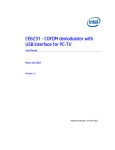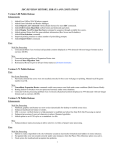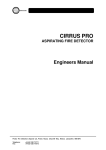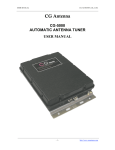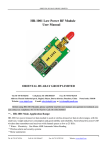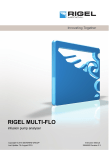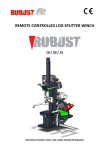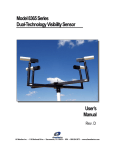Download Operation Instructions
Transcript
WIDE BAND LIGHTWEIGHT DIPOLES TWB 2530/100 (100W) TWB 2530/400 (400W) TWB 2530/1k (1kW) USER MANUAL TWB-11 WIDE BAND TACTICAL DIPOLE ANTENNA SYSTEMS TWB 2530/100 (100W) TWB 2530/400 (400W) TWB 2530/1k ) (1kW) TWB - 11 USER MANUAL BRIEF DESCRIPTION The TWB2530 is a lightweight transportable 3 element horizontal bi-conical loaded dipole antenna system, supplied complete with its own 11m support mast. The complete system is stowed in a PVC nylon kit bag for transportation. PARTS IDENTIFICATION PART NO QTY QTY QTY TWB2530 TWB2530 TWB2530 /100 /400 /1kW TWB -1 2 2 2 TWB -2 6 6 6 TWB -3 6 - 6 TWB -3A - 6 - TWB -4 6 6 6 TWB -5 6 6 6 TWB -6 - - 1 TWB -7 1 1 1 TWB -8 1 1 1 DESCRIPTION Upper elements 17.22m long, c/w termination and strain relief, stored on black polypropylene storage boards. Lower elements c/w termination adjustable end ropes and insulators. Element load assembly 400 watt. Element load assembly 100 watt. Carbine hooks. Fitted to TWB-2 (lower elements). Lower element guy stakes 15" x 1" x 1" tee section. Balun transformer 1kW fitted 'N' connector. Top spreader assembly, c/w strops. RG213 cable assembly, c/w strain relief and 'N' 50 ohm connectors. TWB -9 - 1 - TWB -10 1 - - TWB -11 TWB -12 1 1 1 1 1 1 TWB -13 6 6 6 TWB -14 1 1 1 Balun transformer 400W fitted 'N' connector. Balun transformer 100W fitted 'N' connector. User manual. Roll up kit bag. 2m long spigoted mast sections glass fibre. Mast base, cast aluminium. TWB -15 2 2 2 Base anchor pins 12" x 3/8". 4 Top stay assembly, all fitted to 4 way guy ring, c/w adjusting hanks. (Coded Red) Middle stay assembly, all fitted to 4 way guy ring, c/w adjusting hanks. (Coded Blue) TWB -16 4 4 TWB -17 4 4 4 TWB -18 4 4 4 TWB -19 4 4 4 TWB -20 4 4 4 TWB -21 1 1 1 Bottom stay assembly, all fitted to 4 way guy ring, c/w adjusting hanks. (Natural) 27" long 1 1/2" x 1 1/2" tee section mast ground stakes. Carbine hooks fitted to TWB19 (guy stakes). Sledge hammer. SITE PLAN FOR TWB Care should be taken to familiarise yourself with all the components before attempting to erect the antenna system. NOTE: Be careful that the power rating of the antenna system you are using is equivalent to, or greater than the transmitter output. If the power output of the transmitter is greater than the antenna rating, damage can result to both units. SITE SELECTION The TWB series antenna system requires a clear site of 12-15m wide by 52-57m long. The stays are overlength, in order that uneven ground can be accommodated. COMMENCING INSTALLATION (This should be read in conjunction with the series of photographs) Select the mast base and 2 anchor pins (TWB-14 and TWB-15) and pin the mast base to the ground with the securing holes along the major axis. Mark out the mast anchor points as per the plan 3 mast sections (TWB-13) joined together will give the correct radius. Knock in the 4 guy stakes (TWB-19), with the carbine hooks pointing toward the mast base, using the hammer supplied (TWB-21). Mast assembly can now begin; by first laying the 6 mast sections along the major axis, with the smaller diameter spigot towards the top, do not join together at this stage. The 3 sets of stays can now be fitted to the mast, by fitting the guy ring over a spigot, to come to rest on the spigot shoulder. The mast stays are fitted to every second section as follows: TWB-16 TWB-17 TWB-18 (Top stay, coded Red) (Mid stay, coded Blue) (Bottom stay, Natural) 36' level 24' level 12' level The mast sections can now be joined together. Unreel the mast stays towards the bottom of the mast, being careful not to tangle them. Pull 3 stays (one from each level) toward a stake on the minor axis and make off in the carbine hook, tensioning lightly with the plastic adjuster. Repeat for the 3 stays on the other minor axis being careful to ensure that these are 180 degrees away on the guy band from the first set you have fixed. These stays can also be lightly tensioned. The back stays can now be loosely fixed to the stake under the line of the mast, the 3 remaining stays should be pulled out in readiness for erection. Fit the antenna spreader (TWB-7) to the top mast section spigot and locate with the balun transformer (TWB-10 100W or TWB-9 400W or TWB-6 1kW). Fit coaxial cable to strain relief hook on transformer and connect 'N' connector, first removing the protective dust cap. The coaxial cable should be passed under the strop attached to the spreader, to ensure it does not become entangled when the mast is upright. Unreel the cable along the line of the mast to the mast base. Fit the two upper elements (TWB-1) to the strops on the spreader. NOTE: By laying the elements on the ground whilst on the spools, you will be able to see that one is centre, with two outer spools. These should be connected to the spreader strops in this orientation. Fit both sides of the elements to the spreader and connect the fork terminals to the balun transformer lugs. Unreel the elements to their full lengths, 3 to one major axis point, 3 to the other. Remove the storage boards and stow in kit bag. The antenna system is now ready to be pulled to the vertical. PULLING TO THE VERTICAL (Please refer to the series of photographs) Place the foot of the mast in the mast base cup - One man positions himself at the head of the mast, the other gathers up the 3 forward stays which are not attached to a stake, pulls all three to an even tension and prepares to pull back hard. IMPORTANT: Do not attempt to pull on the antenna elements, as serious damage could occur. At the mast head the other person lifts the mast head over his own head and begins to walk down the mast, raising it over his head as he goes. The man on the stays pulls back until the mast is vertical, all the remaining stays can now be fixed to their stake, and all stays are tensioned, leaving the mast straight and rigidly held. SAFETY NOTE: Whilst raising the mast, great care should be taken not to fall over any of the stakes, and that no wires become entangled. The antenna is now ready to be fully assembled, by fitting the 6 loads (TWB-3 400W/1kW and TWB-3A 100W) to the upper elements by means of the carbine hooks and connecting the fork terminals to the loads. The 6 lower element assemblies (TWB-2) are now fitted to the loads via the carbine hook and connecting terminals. The 6 stakes (TWB-5) are now driven in, 1.2m apart at the extension of the major axis. These points can be measured by use of the actual element. Connect lower elements to stakes using carbine hooks and tension. The whole antenna assembly is now ready to be connected to your transceiver. NOTE: Ensure that the antenna is as straight as possible. The top spreader assembly is free to rotate on the mast. The complete antenna can be rotated, by uplifting the 6 tee anchors (TWB-5) and re-locating. The technical specification of the antenna is enclosed and should be referred to for signal distribution (Polar diagram). HINTS ON USE HF antennas are susceptible to degradation in performance by a number of factors, mainly due to location i.e. close proximity of foliage, large vehicles, or escarpments, buildings, etc. Poor soil conductivity, humidity and a range of naturally occurring phenomena. Erecting the system very close to trees, or escarpments and buildings should be avoided where possible. The antenna is designed for use from 2.5-30MHz, but in some locations a slightly higher than average VSWR will occur between 14 and 14.2MHz. This is due to ground proximity and that fact that the antenna is very close to the ground in terms of wavelength at HF frequencies. FIELD REPAIRS It is strongly recommended that damaged or inoperative parts are replaced with new items, however, some field repairs can be carried out in emergencies. 1. The elements can be joined by stripping back the outer coating of PVC and tying with a reef knot. 2. Non-conducting ropes and straps can be tied using reef, or other suitable knots. 3. The mast can be used at varying heights, should a mast section be damaged or broken. 4. Other natural objects such as tree stumps, rocks, etc, can be used to support the system, should anchors be lost or damaged. RE-STOWING AFTER USE Operators should learn by heart the location of each component in the kit bag and all components should remain in the same relative location. This will help speed assembly and 'on air time' and save frustrating searches for 'lost' components. All components should be clean and free of moisture before stowing. This will aid the longevity of each system. When not in use, all components should be stored in the kit bag (TWB12). Before going into the field, operators should train by assembling, erecting, using and then de-rigging and stowing the TWB2530 so that a routine can be worked out between 2 or 3 people. This will help rapid deployment and deployment under hostile conditions and keeps wasted time to a minimum. Some users may wish to vary the routine laid down here, to suite their own organisation. A target time of 15 minutes should be set for the assembly and deployment of the TWB2530. In practice we have found that 25-30 minutes for 2 people is average. TWB2530/100 and TWB2530/400 erection procedure. Use this in conjunction with the text. The complete antenna, unwrapped, ready for deployment. Pinning the mast base to the ground. Marking out the guy radius, using 3 mast sections. The foot of the mast in the cup of the base. Guy assembly ready for fitment of the mast spigot. Guy ring on the spigot shoulder, with the reset mast section ready to locate. Note that the knots are pulled clear of the shoulder, so that the locating section sits squarely on the guy ring. Top crossarm and balun transformer Assembly on mast head. Ensure that coaxial cable is passed under the crossarm catenary. Ensure that the coaxial connector protective dust cap is in place when the antenna is not in use. Connecting the antenna elements to the balun transformer. The crossarm rigged with coaxial cable and antenna element. Coaxial cable strain relief fitting on balun transformer. Pushing up the mast. Guy stake with all stays attached and adjusted. Connecting loads to upper and lower elements. Comparison between CC-104017-3A (100W) & CC-104017-3 (400W) load resistors. The 400W unit is larger. WHAT IS THE BEST FREQUENCY? Selecting the best HF frequency for communicating with another station is often a difficult task for radio operators, because of the ever-changing factors that determine the paths of radio waves. However, with some practice and some familiarity with these factors, proficient radio operators can select an operating frequency that will provide the best chance for communications at a given time. Although there are too many variables to allow completely accurate forecasting of optimum frequencies over any distance at any time, the following descriptions are intended to provide enough information to give the radio operator a feeling for the factors that must be considered when selecting a frequency for communications over a known distance. This information assumes that the transceiver, antenna and counterpoise or ground are properly set up and connected, and that the antenna is located in the clear; as far as possible from surrounding buildings, trees and other obstacles. Short Range: 1 to 30km HF radio wave propagation over short range depends primarily upon the direct, line-of-sight path between the antennas of the communicating stations. Obstacles such as buildings and trees will weaken signals on the direct path, and hills or mountains may block the signals entirely. Therefore it is important to set up the antennas within, or as near as possible to, the line-of-sight path between them. For best coverage in all directions, this calls for the highest practical location, but for optimum signal in one direction only when a hill or mountain is available, the antenna is better set up slightly below the peak on the favouring side, as shown in Figure 1. Generally, any frequency propagates well over line-ofsight, but often the best frequency is one on which noise and interference from undesired signals are minimal, usually between 20 and 30MHz. Antennas at both stations should be vertical. FIGURE 1 - Optimum Antenna Location Fortunately, there is another propagation factor that allows communication even when the direct path is obstructed: this is reflection. HF radio waves reflect off of just about anything, including even the atmosphere, to varying degrees. In fact it is because of this that HF communications are possible beyond line-of-sight. This is also the reason why, in many cases, communications are still possible (although generally weaker) even when buildings or low hills obstruct the direct path. In such situations it is often possible to improve signals greatly by minor relocation of the antenna (perhaps introducing a better reflection path). At the longer limits of short-range communications (20-100km), the transmitted signal is weakened by dispersion and absorption by the atmosphere, and the curvature of the surface of the Earth begins to obscure line-of-sight. At this range the choice of frequency becomes more critical. Communications are generally possible even beyond line-of-sight, because of slight bending (refraction) of the radio waves by the atmosphere close to the ground (Figure 2). Low frequency HF signals carry along the ground more readily than those at higher frequencies, but the lower frequency signals are also absorbed more readily. However, the effects of the atmosphere on radio signals vary greatly between day and night, and with changes in season and temperature. Therefore the best frequency for communications will also vary between day and night, and from season to season. During daylight hours on a non-line-of-sight path between 20 and 100km, frequencies above about 8 or 9MHz will usually not be useful. The best frequency is likely to be found between 2 and 8MHz, with the best choice with a vertical antenna for distances out to about 50km likely to be the quietest frequency around 6 to 8MHz. During hours of darkness, as there is much less absorption, signals may be stronger on lower frequencies, although noise will be a problem at the lower frequencies in the summer. One other factor that becomes important at these ranges is the conductivity of the ground itself. Salt water, being highly conductive, will often allow direct communications over more than 100km; while rock or sandy soil may limit communications to 20km or less. In all cases, communications will generally be better if a ground rod is installed and connected to the grounding terminal on the antenna tuner or transceiver, along with the counterpoise wire, instead of when using the counterpoise wire alone. See Figure 3. Finally, it is important to note that the maximum range for direct or surface wave communications is largely dependent upon the relative physical locations of the antennas, and this range is unlikely to exceed 100km over land (and will usually be much shorter, around 20-50km), even under ideal conditions. However, when short range communications are possible, they will also be the most reliable, and it should not be difficult to maintain communications on one or two frequencies 24 hours a day, year round. Medium Range: 30 to 500km At distances beyond those which support direct or surface wave communication, radio communications must rely upon reflections from the ionised layers of the atmosphere, called the ionosphere. Radio waves reflected from the ionosphere are called skywaves, and can provide stronger signals than surface waves at distances greater than several kilometres, because skywaves are not subject so much to the heavy absorption that occurs to surface waves. There are actually several layers of the ionosphere that can reflect radio waves between about 100 and 420km above the surface of the Earth. The existence of these layers, and their actual altitude and density at any given time, is determined by the sun's energy, which varies according to latitude and the time of day, season of year, and also over an 11-year cycle. The ionospheric layers are most dense just after noon, and least dense just after midnight. The ability of the ionosphere to reflect radio waves is determined by the altitude and density of the layers, and also the frequency in use. Some portion of the radio signals leaving the transmitting antenna rise through the lower atmosphere until they reach these layers, and if conditions are just right, the signals are then reflected back down to the receiver. Under ideal conditions and at the ideal frequency, such skywave signals can provide loud and clear communications over very long distances. Unfortunately, it is impossible to always predetermine what the ideal conditions and frequency are, but by understanding some of the principles involved, the operator can still often determine the most likely time and frequency for making contact. As shown in Figure 4, the propagation distance of skywaves is determined by the altitude at which they are reflected back down toward the ground: if the reflecting layer is high the distance will be longer than if the reflecting layer is low. During hours of daylight, the reflective layers are at lower altitude than at night, and thus are most useful for medium range communications. After dark these same signals will reflect at higher altitude, and thus have longer range. Figure 5 shows another factor affecting reflection by the ionosphere; the wave angle. Although signals leave the antenna at a wide range of angles, only those below a certain "critical angle" will be reflected by the ionosphere. The critical angle is related to the density of the ionospheric layer and the frequency of the signal. Higher angle (and higher frequency) waves pass through the ionosphere and off into space. This means that the distance between the maximum range of the surface wave (point A) and the minimum range of the skywave at the highest possible angle (shortest possible hop, point B) cannot be reached, and hence this region is called the "Skip Zone". The critical angle is higher for lower frequencies, and lower for higher frequencies. The existence of the Skip Zone means that for medium range communications there is usually a frequency limit above which communications are not possible: signals above the limit will be reflected at an angle that will cause them to return to the ground beyond the desired receiving station. Table 1 shows approximate minimum and maximum ranges for several frequencies. Obviously, with optimum day and night frequencies being so different, the periods around sunrise and sunset are highly unstable, with optimum communication frequencies shifting rapidly upwards within a few hours of sunrise, and downwards within a few hours of sunset. For this reason, any scheduled communications during these periods should include a number of channels to check at widely different frequencies. Contacts are likely to fade out, forcing a shift several MHz higher or lower. For medium range communications at night, use the lowest available frequency that is not masked with noise. This last condition, noise, will be higher in the summertime (forcing higher frequency operation) because of electrical storms, than during the winter. Also, the increased amount of sunlight during the summertime increases the density of the ionospheric layers, which results in greater absorption of the lower frequencies, and better refraction of the higher. This also calls for using generally higher frequencies during the summer. Of course, seasonal effects are greater farther from the equator. The reliability of medium range communications is not as good as for short range, and it may be difficult, if not impossible, to maintain communications at all hours of day and night. To do so would certainly require at least several changes of frequency as ionospheric conditions change. In practice, there are often times (particularly during daylight) when the lowest frequency that could provide the necessary hop distance will be totally absorbed, in which case contact will not be possible (until later in the day). Solar conditions, discussed below, also affect medium range communications, particularly at higher frequencies. Long Range: 500+km At long range the effects of ionospheric variations mentioned above are greater, and reliable prediction of optimum communications frequencies is more difficult. Even so, it is worthwhile to bear in mind that worldwide communications are possible even with 10 watts of power when conditions are just right. As with medium range communications, long range involves use of higher frequencies during the day, and lower frequencies at night. As can be seen from Table 1, the optimum frequency for long range is higher than that for medium range when time and all other factors are equal. Note however, that frequencies above about 15MHz are usually useless for medium or long-range communications after dark. Because of greater dependence of long-range communications on the ionosphere, it is useful for the operator to maintain constant awareness of long range propagation conditions. This can be done by regularly listening to the international broadcasting bands and noting trends in band activity and signal strengths. Noting the time a station is heard and the location of the broadcasting transmitter can help in planning two-way communications on nearby frequencies, although one should bear in mind that broadcasters use thousands or millions of watts, and so their signals will propagate acceptably where normal transceivers may not. By listening it can usually be shown that as one tunes higher in frequency signals from a particular region will become stronger until they suddenly disappear. The strengthening of signals is caused by the lessening of absorption as frequency is increased, and the drop off of signals results when the signals are no longer refracted sufficiently to return to the ground at the receiver. One can gather from this that the best frequency for communication is just below that at which signals are no longer heard (as one tunes upward). The reliability of long range communications depends, in addition to all of the factors mentioned previously for short and medium ranges, upon solar conditions as they effect the geomagnetic field of the Earth (since this, in turn, determines the condition of the ionosphere). This subject is very complex, so only a few of the more useful factors will be mentioned here. The reliability and stability of radiation reaching the Earth from the Sun goes through two overlapping cyclic repetitions: one every 27 days, and one approximately every 11 years. The nature of the 27-day cycle simply results in radio propagation conditions on one day being generally similar to conditions 27 days before, and 27 days after, that day. This is because the Sun takes approximately 27 days to make one full rotation. The importance of this cycle is that poor conditions caused by flares and other disturbances on the surface of the Sun will tend to repeat every 27 days. Table 1 - Useful Skywave Ranges For HF Frequencies Frequency (MHz) Noon (km) Midnight (km) 2 0 - 120 0 - >> 4 0 - 400 0 - >> 8 0 - 800 500 - >> 10 300 - 1600 1000 - >> 15 800 - >> 1600 - >> 20 1200 - >> None 25 1600 - >> None 30 2000 - >> None The 11-year cycle has a much more pronounced effect on radio communications: at the peak of the cycle it is often possible to communicate over 10,000km with just a few watts of power on frequencies near 30MHz, while at the bottom of the cycle all but short range communications will usually be impossible on frequencies above about 22MHz. Interestingly, communications at low frequencies (2 to 6MHz) are better at the bottom of the cycle, because of less absorption of signals by the ionosphere resulting from less excitation energy from the Sun. A minimum of this 11-year cycle will occur between 1986 and 1988, followed by a peak in 1990-1991. Despite these regular cycles, the effect of solar radiation is subject to constant, ultimately unpredictable changes caused by random events on the surface of the Sun. Occasionally these are especially noticeable, as for example when a solar flare causes a partial or complete fadeout of all signals on shortwave frequencies, which might occur several times a year. Because of these random factors, long distance HF communications are ultimately unreliable. In conclusion, selection of the optimum frequency for long range HF pointto-point communications requires some familiarity with prevailing ionospheric conditions at the time of interest. Communications are only possible at certain times each day (if at all), with the length of time available being shorter for longer distances. Selection of frequency is critical, as the useful range of frequencies becomes narrower at longer distances, and if a schedule is set up there should be several alternate frequencies to try (beginning at the highest expected frequency, an working lower), to take advantage of the lower absorption at higher frequencies, and to allow for random changes in ionospheric conditions. If contact cannot be made on the established frequencies, try again an hour later, and starting an hour earlier on the following day.






























